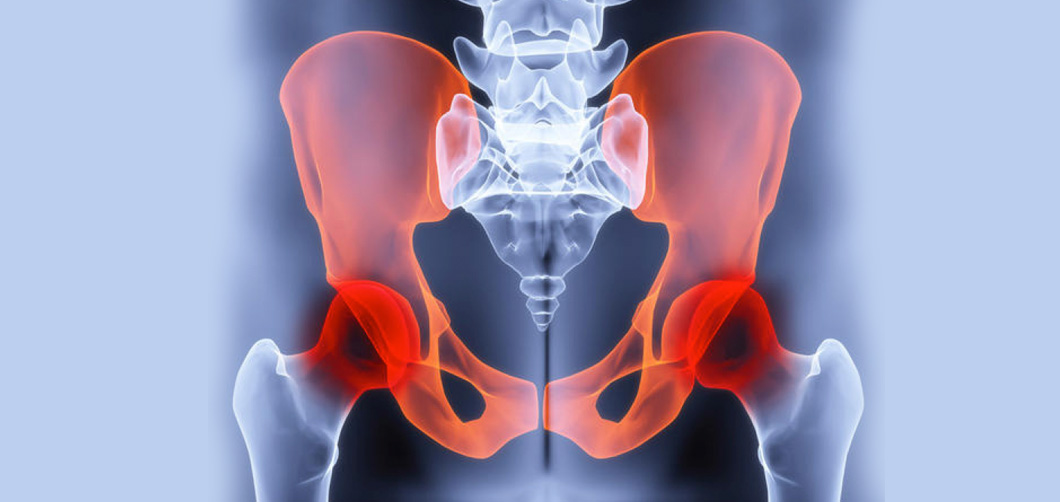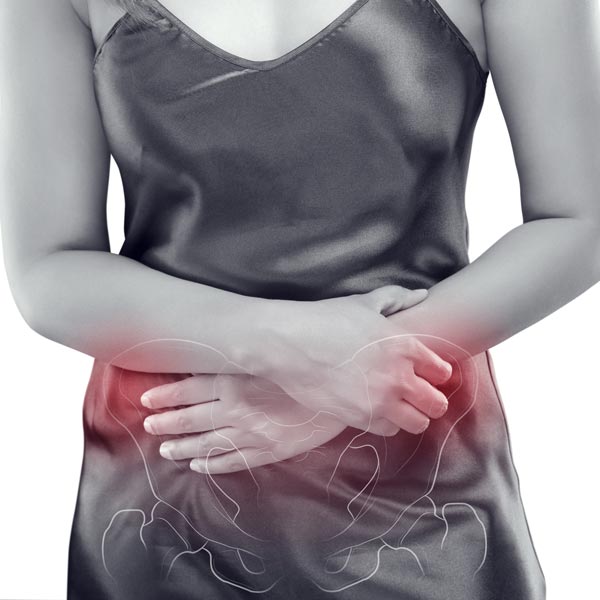Common Causes
What is Chronic Pelvic Pain?
Any pain in the area between your hips and the belly button is pelvic pain. It becomes chronic when it lasts for six months or more. Below explains the common causes of pelvic pain.
The type of pain associated with chronic pelvic pain can vary from woman to woman. Some experience severe and constant pain, others describe intermittent bursts of pain, and still, others have a constant dull aching. The intensity of the pain varies and is often relieved sometimes improved by lying down.
Some women may also experience pressure within the pelvis. Certain activities can sometimes increase the pain, including intercourse, using the toilet, or sitting for long periods.

Common Causes of Pelvic Pain
Several diseases can cause chronic pelvic pain, but it can also be a stand-alone condition. To treat your chronic pelvic pain, your doctor will first need to determine its cause. Sometimes, treating the disease causing the pain can be enough to eliminate the pain.
However, even if your doctor cannot identify your pain’s direct cause, they can still attempt to reduce the pain and other symptoms through treatment.
These are some of the more common causes of chronic pain in women.
Chronic pelvic pain can be debilitating and affect the quality of patients’ daily lives. Women are disproportionately affected by chronic pelvic pain. Nearly 15% of women have reported chronic pelvic pain to their doctors.
Unfortunately, doctors often dismiss pelvic pain for women. Although it might be hard to get a diagnosis, there are treatments available that can alleviate your pain and allow you to live a more comfortable life.
Irritable bowel syndrome can also cause chronic pelvic pain. Its symptoms include bloating, constipation, and diarrhea, which can all cause discomfort and pain.
Interstitial Cystitis causes pain in the bladder and makes you need to pee urinate more frequently than usual. The pain may increase as you fill your bladder and decrease immediately after relieving yourself.
Endometriosis is a largely under-diagnosed condition that an estimated 10 - 20% of women suffer from
Endometriosis causes the causes, the lining of the uterus it means that some tissue from your to grow outside the womb. It causes inflammation and bleeding within the pelvic cavity, leading to pelvic pain that is especially severe during menstruation.
Chronic pelvic inflammatory diseases, often sexually transmitted, can cause scarring if left untreated. This scarring can cause chronic pelvic pain.
Fibromyalgia, pelvic floor muscle tension, pubic symphysis, and hernias can all cause chronic pelvic pain.
Severe psychological stress can increase your risk of developing chronic pelvic pain. If you suffer from depression or chronic stress or were sexually or physically abused, you might experience pelvic pain. Unfortunately, chronic pain often increases emotional distress, creating a vicious cycle.
Pelvic Congestion Syndrome (PCS) is a common but under-diagnosed cause of chronic pelvic pain. With PCS, pelvic pain is caused by varicose veins surrounding the uterus, a condition that occurs when vein valves stop functioning correctly. Blood pools in the pelvis and/or legs backs up and creates congestion, which can result in a variety of symptoms including pelvic pain, bloating, and heaviness, as well as leg symptoms like pain and swelling. Some patients may also have bulging veins of the legs or genitals.
Visit this page for information on Pelvic Congestion Syndrome.
Doctors to Visit
When to See a Doctor?
If your pelvic pain interferes with your daily life activities, you should see a doctor. For women who are suffering from pelvic pain and have excruciating periods can be a sign of endometriosis; long-term pain after pregnancy can be from pelvic congestion syndrome. Pain during or after sexual intercourse can also be a warning sign.
The team at CVM questions patients and identifies certain buzz words like "feeling heavy" in the groin region and will find the underlining cause of the pain. CVM also asks questions about pelvic pain during or after sex. It is best to make an appointment to determine the causes of your chronic pelvic pain after your gynecologist ruled out non-vascular causes of your discomfort.
A vascular specialist can determine whether the pain is related to improper vein drainage in the pelvic region using an ultrasound device and then uses a venogram procedure when necessary to validate the findings.
Think you may have vascular symptoms of Chronic Pelvic Pain?
Chronic Pelvic Pain Treatment
A Step-by-Step Guide to Treating a Chronic Pelvic Pain Caused by a Vascular Disorder
Diagnosis
In addition to tender ovaries during an examination, your pain must be present for at least six months for it to be considered chronic. Your doctor will often perform an ultrasound; however, the results may be inclusive if the veins are recumbent.
Other possible tests include venography, CT scan, MRI scan, or magnetic resonance venography. A laparoscopy can also confirm the diagnosis. The gold standard of diagnosis is a procedure called a venogram.
Treatment Options
One treatment option for chronic pelvic pain is a hysterectomy. However, this treatment is only effective for 75% of women, with the remaining 25% still reporting pain after the surgery. It is also the most aggressive form of treatment and carries with it the most risk and recovery.
General treatment options of chronic pelvic pain include medications to treat the pain, hormone therapy if the problem is menstrual, antibiotics to treat an infection, or antidepressants if the cause is depression or previous sexual assault.At CVM, we focus on treating chronic pelvic pain that arises from Pelvic Congestion Syndrome. Our innovative treatments include the following.
- Compression Garments Bandages
- Minimally Invasive Treatment such as venoplasty using a "balloon" to expand compressed veins.
- Placing a venous stent, or a permanent intravascular device, inside the vein to open areas of congestion. Even if you have been turned away by doctors in the past, at CVM, we understand the pain that comes with Pelvic Congestion Syndrome and can offer hope for symptom improvement.
- These venous stents are very durable lasting decades.
These procedures are less risky and fast recovery times. Patients can go back to work the next day. The procedures require no hospital stay, no bed rest, no large incisions, and no scarring.
Prognosis
Pelvic Congestion Syndrome is not life-threatening, but many women struggle to find permanent pain relief. Some hormone therapies cannot be continued for longer than six months, while other, more permanent treatments have a high risk of being unsuccessful.
You will need to work closely with your doctor to determine the best treatment options, and remain in contact with them throughout your treatment. Your doctor may need to try several methods before finding the best treatment for you.
It might seem daunting, but it is possible to live a relatively pain-free life even with Pelvic Congestion Syndrome (PCS). Every woman’s body reacts differently to treatment options, and it might take some time to find your solution.
What to Expect After Treatment From CVM?
At our Vascular Surgery in Silver Spring, Maryland, our mission is to help patients with their vascular diseases in a cost-effective and compassionate manner. We specialize in the diagnosis and treatment of venous and arterial diseases in the legs, feet, and pelvis. Our world-class providers are the most experienced in the specialty and work with patients to develop a treatment plan that is custom-tailored to their unique situation.
Typically, this process involves an initial consultation and ultrasound scan at one of our accredited facilities. After reviewing the results of your scan and obtaining a thorough medical history, our providers will discuss the results with you and help you decide on the next steps.
Our health care providers use several diagnostic tests to help determine what vascular diseases may be causing your symptoms. Our initial evaluations utilize ultrasound because this non-invasive imaging modality helps us verify our suspicions on whether your symptoms are caused by underlying vascular disease.
Home Remedies to Reduce Pelvic Pain
Several home remedies can help reduce your pelvic pain. They won’t treat the cause, but they might give you relief while you wait for a diagnosis.
- Pain medicines: Take Advil or Tylenol as directed.
- Exercise: Even a light walk around the block can increase your blood flow. Endorphins, which come from exercising, can also help reduce pain.
- Take a hot bath: Soak in a warm tub or use a hot water bottle.
- Relaxation: If anxiety or depression contribute to your pelvic pain, yoga or meditation might help.
Psychological Impact on Women Suffering from Chronic Pelvic Pain
Pain is linked intrinsically to our psyche. Some women who suffer from chronic pelvic pain also suffer from depression. Unfortunately, depression can cause pain, which can also cause depression, creating a cycle.
Chronic pain can also lead to fatigue, depression, or anxiety. When something is continuously hurting, it can have an enormous impact on your mental health, especially when your doctor can't find the cause of your pain. Some patients even seek help from a mental professional because medical professionals can't find the underlining cause of the symptoms.
A vascular specialist would need to make a proper analysis of the veins in the pelvic region and legs to rule out a vein disorder. This will determine if there is venous reflux in the region or compression of the iliac vein. It is important to check proper blood drainage in the pelvis and abdomen. If you visited an ObGYN and other specialists about pelvic pain, then a vascular specialist can rule out a poor blood circulation issue.
Think you may have vascular symptoms of Chronic Pelvic Pain?
FAQs
Risks are involved in any procedure. This is a minimally-invasive procedure meant to decrease risk. There is no open surgery, no hospital stays, and minimal sedation is used by the provider. Please speak with your provider to learn more about risks and benefits of the procedure. The benefits are based on the current symptoms of the patient and prognosis given by the specialist.
A gynecological evaluation from OB-GYN is highly recommended before seeking vascular treatment for chronic pelvic pain. Procedures are recommended when conservative measurements have been exhausted. These procedures are clinically proven to be effective for our patients. There are many testimonials of positive results from patients and peer-reviewed journals that praised the conclusions of the studies conducted by Dr. Pappas and Dr. Lakhanpal that you can view at the, Lakhanpal Vein Foundation.



